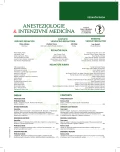Preventive immobilisation of the cervical spine in pre-hospital emergency care in trauma patients: update
Authors:
R. Jančálek 1,2
Authors‘ workplace:
Neurochirurgická klinika FN u sv. Anny v Brně a Lékařské fakulty Masarykovy univerzity, Brno
1; Zdravotnická záchranná služba Jihomoravského kraje, Brno
2
Published in:
Anest. intenziv. Med., 27, 2016, č. 6, s. 375-379
Category:
Overview
Cervical spine or spinal cord injury occurs in 2–3% of trauma patients. Preventive immobilization of the cervical spine during prehospital care in trauma patients is common clinical practice because of the secondary spinal cord injury risks due to patient manipulation. The potential negative impacts of immobilization with hard cervical collar have led to the rise of the concept of selective cervical spine immobilization. Cervical immobilization of trauma patients who are (i) awake, alert, and are not intoxicated; (ii) who are without neck pain or tenderness; (iii) who do not have abnormal neurological examination; and (iv) who do not have any significant associated injury that might detract from their general evaluation, is not recommended. On the other hand, if any of the above four criteria is present, immobilization of the cervical spine is indicated. Spinal immobilization in patients with penetrating trauma is not recommended because of the increased mortality due to delayed resuscitation.
KEYWORDS:
prehospital care – cervical spine – trauma – immobilization
Sources
1. Sundstrøm, T., Asbjørnsen, H., Habiba, S., Sunde, G. A., Wester, K. Prehospital use of cervical collars in trauma patients: a critical review. J. Neurotrauma., 2014, 31, 6, p. 531–540.
2. Davis, J. W., Phreaner, D. L., Hoyt, D. B., Mackersie, R. C. The etiology of missed cervical spine injuries. J. Trauma., 1993, 34, 3, p. 342–346.
3. Platzer, P., Hauswirth, N., Jaindl, M., Chatwani, S., Vecsei, V., Gaebler, C. Delayed or missed diagnosis of cervical spine injuries. J. Trauma., 2006, 61, 1, p. 150–155.
4. Abram, S., Bulstrode, C. Routine spinal immobilization in trauma patients: What are the advantages and disadvantages? Surgeon, 2010, 8, 4, p. 218–222.
5. Hauswald, M., Ong, G., Tandberg, D., Omar, Z. Out-of-hospital spinal immobilization: its effect on neurologic injury. Acad. Emerg. Med., 1998, 5, 3, p. 214–219.
6. Marshall, L. F., Knowlton, S., Garfin, S. R. et al. Deterioration following spinal cord injury. A multicenter study. J. Neurosurg., 1987, 66, 3, p. 400–404.
7. Thumbikat, P., Hariharan, R. P., Ravichandran, G., McClelland, M. R., Mathew, K. M. Spinal cord injury in patients with ankylosing spondylitis: a 10-year review. Spine, 2007, 32, 26, p. 2989–2995.
8. Lazennec, J.-Y., D’Astorg, H., Rousseau, M.-A. Cervical spine surgery in ankylosing spondylitis: Review and current concept. Orthop. Traumatol. Surg. Res., 2015, 101, 4, p. 507–513.
9. Heath, K. J. The effect of laryngoscopy of different cervical spine immobilisation techniques. Anaesthesia, 1994, 49, 10, p. 843–845.
10. Thiboutot, F., Nicole, P. C., Trépanier, C. A., Turgeon, A. F., Lessard, M. R. Effect of manual in-line stabilization of the cervical spine in adults on the rate of difficult orotracheal intubation by direct laryngoscopy: a randomized controlled trial. Can. J. Anaesth., 2009, 56, 6, p. 412–418.
11. Gruen, R. L., Jurkovich, G. J., McIntyre, L. K., Foy, H. M., Maier, R. V. Patterns of errors contributing to trauma mortality: lessons learned from 2,594 deaths. Ann. Surg., 2006, 244, 3, p. 371–380.
12. Santoni, B. G., Hindman, B. J., Puttlitz, C. M. et al. Manual in-line stabilization increases pressures applied by the laryngoscope blade during direct laryngoscopy and orotracheal intubation. Anesthesiology, 110, 2009, č. 1, s. 24–31.
13. Turner, C. R., Block, J., Shanks, A., Morris, M., Lodhia, K. R., Gujar, S. K. Motion of a cadaver model of cervical injury during endotracheal intubation with a Bullard laryngoscope or a Macintosh blade with and without in-line stabilization. J. Trauma., 2009, 67, 1, p. 61–66.
14. Ahn, H., Singh, J., Nathens, A. et al. Pre-hospital care management of a potential spinal cord injured patient: a systematic review of the literature and evidence-based guidelines. J. Neurotrauma., 2011, 28, 8, p. 1341–1361.
15. Totten, V. Y., Sugarman, D. B. Respiratory effects of spinal immobilization. Prehosp. Emerg. Care, 1999, 3, 4, p. 347–352.
16. Hood, N., Considine, J. Spinal immobilisaton in pre-hospital and emergency care: A systematic review of the literature. Australas Emerg Nurs J [Internet]. College of Emergency Nursing Australasia, 2015, 18, 3, p. 118–137.
17. Hoffman, J. R., Mower, W. R., Wolfson, A. B. et al. Validity of a set of clinical criteria to rule out injury to the cervical spine in patients with blunt trauma. National Emergency X-Radiography Utilization Study Group. N. Engl. J. Med., 2000, 343, 2, p. 94–99.
18. Theodore, N., Hadley, M. N., Aarabi, B. et al. Prehospital cervical spinal immobilization after trauma. Neurosurgery, 2013, 72, Suppl. 2, p. 22–34.
19. Bouland, A. J., Jenkins, J. L., Levy, M. J. Assessing attitudes toward spinal immobilization. J. Emerg. Med., 2013, 45, 4, p. e117–e125.
Labels
Anaesthesiology, Resuscitation and Inten Intensive Care MedicineArticle was published in
Anaesthesiology and Intensive Care Medicine

2016 Issue 6
Most read in this issue
- Depth of anaesthesia monitoring
- Thrombophilic conditions during pregnancy
- Regional anaesthesia and haemostasis-modifying drugs – latest recommendations
- Preventive immobilisation of the cervical spine in pre-hospital emergency care in trauma patients: update
